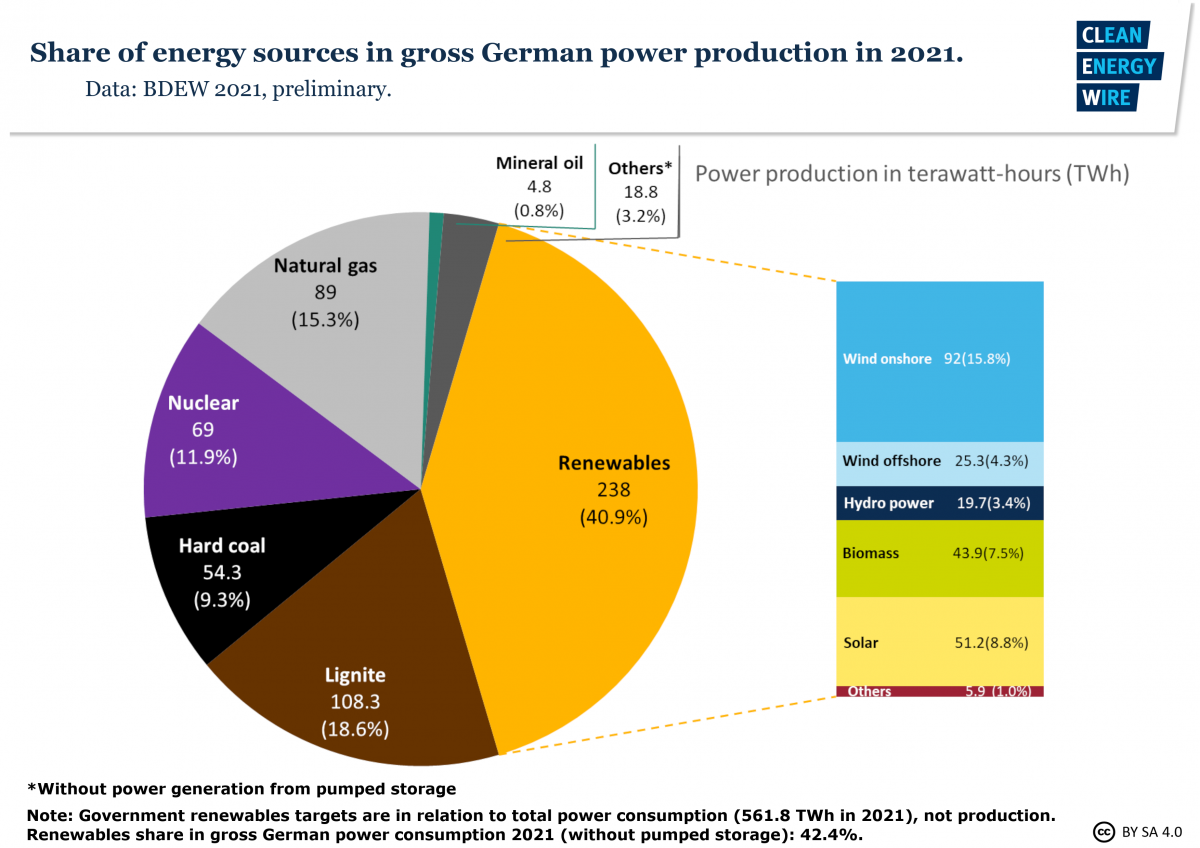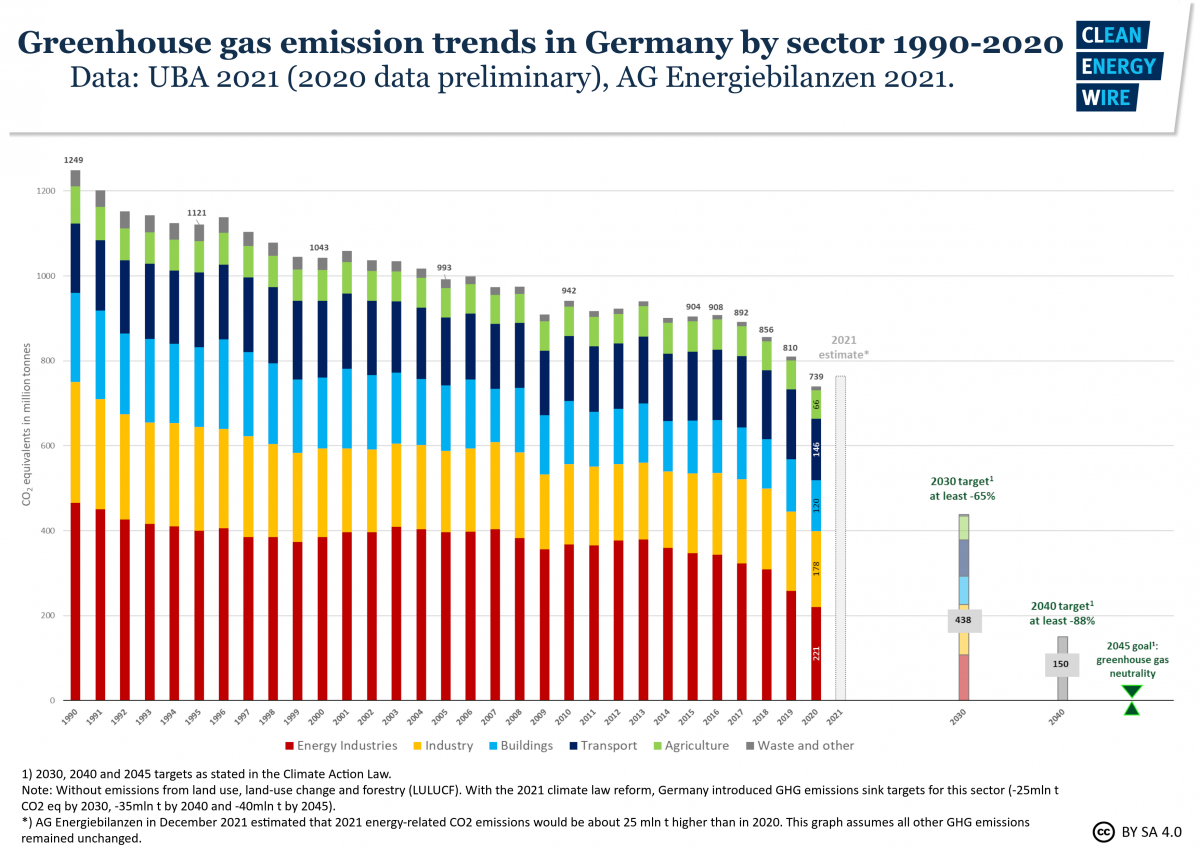Germany’s energy consumption rising, renewables share falling in 2021
The consumption of energy in Germany has increased in 2021 compared to the previous year, while the share of renewable energy sources in power production was in decline, figures released by energy market research group AGEB and by energy industry lobby association BDEW have shown. Energy consumption increased by 2.6 percent (12,193 petajoule) compared to 2020, when economic activity was severely depressed due to the coronavirus pandemic, AGEB said, adding that primary energy consumption in the country still ranked significantly below pre-crisis levels from 2019, as pandemic effects could still be felt in 2021 and supply chain interruptions further obstructed economic recovery.
Very cold weather at the beginning of the year also contributed to higher energy use and, according to AGEB, accounted for most of the increase. On the other hand, price hikes on energy markets and in the European emissions trading system (ETS) “visibly slowed down the growth-driven rise in primary energy consumption”, the researchers said.
The increase in energy consumption and drop in renewable power production add further urgency to the new government of chancellor Olaf Scholz to make good on its promise to ignite a booster in Germany’s energy transition. The Social Democrat’s (SPD) coalition with the Green Party and the Free Democrats (FDP) aims to reduce Germany’s emissions by 65 percent by 2030 and achieve a share of 80 percent renewables in electricity consumption in the same year. It also wants to “ideally” phase-out coal-fired power production completely by the end of the decade.
Coal industry preparing phase-out despite increasing share in power system
In contrast to the government’s plans,coal power consumption increased markedly, with both hard coal and lignite use up by about 18 percent, whereas natural gas increased by only 4 percent. However, statistical effects played an important role in the year-on-year rise, meaning lignite use still was 5 percent lower than in 2019 and even 25 percent lower than 2018, according to coal industry association DEBRIV. However, even though lignite plants had made a “remarkable contribution” to Germany’s supply security this year and domestic supply with the fossil fuel would not be affected by price hikes like gas or oil, the increase in use in 2021 does not change the technology’s overall demise in Germany, DEBRIV head Thorsten Diercks said.
Nuclear power, which will be phased out completely in Germany by the end of 2022, saw an increase of more than 7 percent “due to higher demand, low output from renewables and the development of energy and CO2 prices”. The share of renewables in primary energy consumption fell from 16.5 percent in 2020 to 16.1 percent this year, mainly caused by a drop in wind power generation of about 10 percent due to unfavourable weather conditions.
As a result of the higher overall consumption and comparably weak renewables output, the country's energy-related CO2 emissions this year are expected to be about 25 million tonnes (4%) higher than in 2020, AGEB said. Energy-related CO2 emissions account for about 85 percent of Germany's total greenhouse gas emissions. Assuming that all other emissions remained unchanged, total greenhouse gas output would still remain well below pre-pandemic levels. The country would have reduced emissions by about 39 percent compared to 1990 levels.
New government must install 30 new wind turbines per week - energy industry
According to energy industry lobby group BDEW, total energy sector emissions reached 247 million tonnes in 2021, less than the sector’s 2022 target of 257 million tonnes. In a long-term trend, CO2 emissions from the sector were falling despite the ups and downs caused by the pandemic, while wind power stayed the most important individual power source, BDEW head Kerstin Andreae said. However, the share of renewables in electricity production dropped from about 44 percent in 2020 to just under 41 percent this year, slightly more than in 2019. Andreae argued that the new government’s target of bringing the renewables share in power use to 80 percent by 2030 would still be feasible. “This can be done, even if its very ambitious and requires a fast pace in the next years,” she said.
In order to reach the envisaged capacity of 200 gigawatts (GW) by the end of the decade, the government will face the challenge to add 15GW of solar PV capacity each year, almost three times the 5.8 GW added in 2021. The target of 100GW onshore wind power means that the number of turbines built each week must rise from currently 8 to about 30 if the modern installations are used, she added. The key for achieving this would be to reduce administrative hurdles: “Procedures have to be made more efficient and become digital wherever possible. And we need the required areas and skilled workers who put a faster energy transition into practice,” Andreae said.
Moreover, a faster expansion of grid infrastructure would be equally necessary to achieve the transition, as well as more gas power plants as a bridging technology before they are fully converted to green hydrogen use. She warned that, taken together, about 40GW of secure nuclear and coal power supply would drop out of the system by 2030, meaning new energy infrastructure to adequately replace them needs to be fully operational in less than a decade. “Supply security is the guarantee we need to make sure the climate targets are accepted,” she said.
Andree Böhling of environmental action NGO Greenpeace called the jump in carbon emissions a “poisoned present” by the previous government of conservative Angela Merkel (CDU). Even if Scholz’s coalition is not to blame for the current situation, it will still have to come up with a response quickly, he argued. “Measures of an action programme must tackle the root cause of rising emissions, meaning substantially higher coal use and growing power consumption,” Böhling said, calling for a ceiling on coal power use in the electricity system and ending coal use by 2030.



